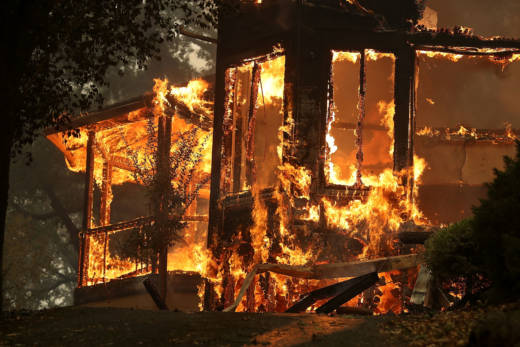The dispatchers stayed on the phone with residents who were stuck, directed firefighters to conduct rescues and sent resources to reports of fires.
“That is a tremendous number of calls for a small facility,” said Cal Fire spokeswoman Lynne Tolmachoff, a former dispatcher. “When you have that many phone calls, it’s almost virtually impossible to keep up with every one of them.”
During those initial minutes, the two dispatchers were effectively in charge of a large part of the response to what would quickly become one of the worst disasters in California history.
Under Cal Fire’s protocol, the command center supervises the response to emergencies until fire crews arrive on the scene.
State fire officials say that of the 172 blazes that started in the first two days of the siege, 18 grew into large, fast-moving wildfires fanned by wind gusts between 40 and 70 mph.
Ten of those major fires broke out in the Sonoma-Lake-Napa unit during the first six hours of the siege. In the first moments of the crisis, the two dispatchers would help kick off a massive mutual aid system that would eventually garner support from scores of fire departments around the state, the U.S. Forest Service, the California National Guard and fire agencies from other states.
Dispatchers who were off-duty rushed into the command center. But the fires they were about to coordinate a response to got in their way as well.
“One of the struggles was the road closures and the fire prohibiting our own folks from getting into work,” Burlew said.
By the next morning, the center was staffed up with a dozen dispatchers. Two dozen other Cal Fire employees from command centers around the state came in to help with deploying resources and answering questions from the public.
At the peak of the fire siege, more than 11,000 firefighters battled 21 major blazes that burned over 245,000 acres throughout Northern California. The fires destroyed 8,900 structures, forced more than 100,000 residents from their homes and killed 42 people.
Cal Fire is reviewing the phone and radio recordings, as well as transcripts of hundreds of hours of calls, as part of the investigations into the causes of the fires, according to Burlew. The agency is also scouring its data to determine whether callers who their dispatchers were in touch with died in the blazes.
“Were some of the addresses that were calling for help people that tragically did not make it?” Burlew said.
The agency is also considering making changes to its dispatch system to improve its response to the next big disaster.
Normally, one dispatcher takes calls while the other one sleeps in the center’s barracks, according to Cal Fire spokeswoman Janet Upton. But, the weekend the fires started, the two dispatchers were awake, Upton said.
“The disaster gives us an experience base to inform future decisions,” Upton said in response to a question over whether there should be more dispatchers in the center during high-fire-risk periods. “I’m confident it will be drawn upon when making staffing decisions next fall,” she said.
Increasing the number of dispatchers has not been easy for Cal Fire, according Daren Watkins, president of the Fire Marshal and Emergency Services Association (FMESA), the union that represents more than 150 Cal Fire communications operators.
“Our staffing levels need to be bolstered year-round,” Watkins said in an interview, adding that there are scores of vacant Cal Fire dispatch positions that have yet to be filled. The union and the agency have been trying to recruit more operators, Watkins said.

